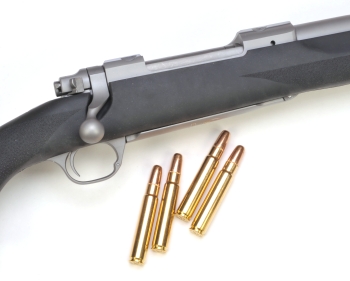 We are all pretty much aware of the dynamics within government that are fueling dramatic increases in the sale of firearms and ammunition. Personally, I believe securing firearms and ammunition as a hedge against future events and circumstances is more than reasonable at this time. I have lived through some very tough times in this country and never felt this way before. In a more positive vein, there is something else going on for firearm enthusiasts, a sort of firearms Renaissance.
We are all pretty much aware of the dynamics within government that are fueling dramatic increases in the sale of firearms and ammunition. Personally, I believe securing firearms and ammunition as a hedge against future events and circumstances is more than reasonable at this time. I have lived through some very tough times in this country and never felt this way before. In a more positive vein, there is something else going on for firearm enthusiasts, a sort of firearms Renaissance.
I can’t remember a time when there were more models and versions of firearms, a time when even mature standard models are subject to fresh creative thinking and evolution. There are lever action rifles with bolt action length barrels, shooting spire tipped bullets that are fed from tubular magazines. Massive revolvers chambered for cartridges that have made their way to use in hunting the world’s biggest and most dangerous game. Mass produced bolt action rifles that, thanks to material, process and machine improvements, now routinely deliver sub MOA performance. The little AR 15, a rifle that began life as a less than appreciated firearm, has not only fostered the modular owner built rifle concept, but its popularity has created whole companies, thousands of jobs and a place to develop new concepts that will apply to more conventionally designed firearms. Finally, the past ten years has accounted for the creation of more survivable and useful cartridges to service these new and enhanced rifles, than had the prior hundred years. Like I said, we are in the midst of a firearms’ Renaissance.
So here’s Ruger and Hornady with a new rifle and cartridge combination. A convincing big and dangerous game stopper, crafted of stainless steel and state of the art synthetic and internally aluminum framed stock, built for the environment where it will be used, with a $1,079 MSRP and a typical selling price $200 lower. Firearms are getting better and they are getting less expensive.
Don’t try this at home…
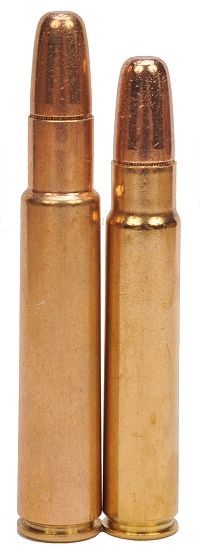
The .416 Ruger is a production cartridge, however, the specifications are not SAAMI listed until they are reviewed and approval by that industry organization. Typically, six months to a year will pass between product introduction and released drawings and specifications, which then triggers support material such as production reloading dies. It’s a good process that brings a number of assurances to the consumer.
Wanting to finish our review of the rifle and cartridge, and not having access to a set of .416 Ruger production dies, I decided to make my own. The .416 Ruger is approximately 0.048″ smaller in diameter at the case head than the .416 Rigby and about 0.034″ smaller at the shoulder. The Rigby case is approximately 0.320″ longer and its neck is nearly 0.200″ longer than the Ruger case.
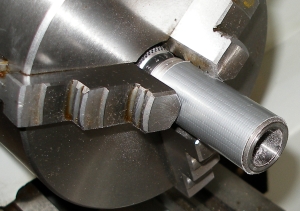
It seemed I should be able to measure each of the two cases case, from case head to shoulder/neck transition subtract the difference and then trim that much off the die length. Neck length was probably irrelevant, only the depth of sizing was of consequence. Hey! It’s a theory and I went with it…I have many theories. So I measured out the dimensional difference between the two cases, as noted. A wrap of duct tape was placed around the die thread to mark the stopping point so I didn’t end up with a .380 ACP neck die, the die was chucked in a lathe and trimmed back. The die threads came out clean, the inside edge was dressed and the die plopped right into the turret press.
Fired .416 Ruger cases neck sized correctly, the expander plug was removed to get minimum workable inside neck diameter for maximum neck tension. An unmodified .416 Rigby seater die served its purpose but, of course, it could not be used to roll crimp. Neck tension was more than enough to secure a bullet and I placed no rounds in the magazine while chronograph and accuracy testing. I was not willing to give my only Rigby seater die to the cause, so further development will wait for factory dies.
Number 1, step forward and state your name…
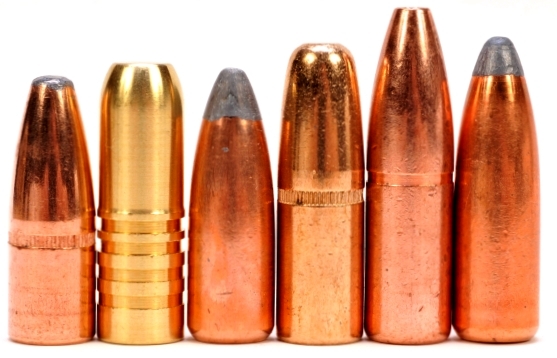
There are lots of excellent bullet available for .416 caliber guns. I’m sure, because of the newness of the cartridge, none had the .416 Ruger in mind when the bullets were designed, but the .416 Ruger with its relatively short neck didn’t seem to notice. 400 grain bullets are pretty much standard fair for the .416’s, but 350 grain bullets are relatively flat shooting and very hard hitting also. L-R Speer 350 grain Mag Tip, 350 grain Barnes Banded Solid, 350 grain Hawk Soft Copper Jacketed, 400 Grain Hornady Dangerous Game Solid, 400 Barnes X, 400 Grain Hawk Soft Copper Jacketed. The Hawk bullets were originally ordered for a .416 Weatherby and have a 0.050″ thick jacket. With the exception of the 350 grain Speer, which is a relatively pedestrian bullet design, the rest are uniquely tailored for a big .416″ application.
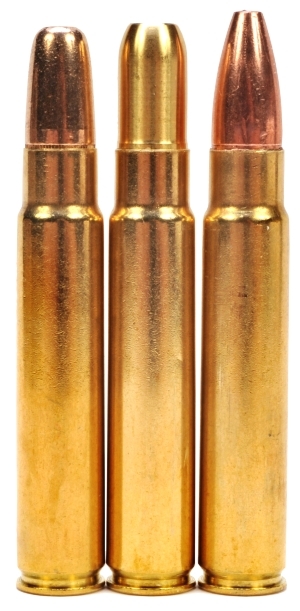
From longest to shortest, all of the bullets noted above seat where intended and actually, with the exception of the Barnes X, took no more room than the factory Hornady 400 grain DGS bullet. The 400 grain Barnes x required only one cannalure groove thickness more to be seated, or approximately 0.070″ more. Everything fed and ejected. I did not fabricate a COL gauge, however, the bolt handle didn’t have to be wrestled down with a pipe wrench to close on any of these handloads. Pictured right, 400 grain Hornady, 350 grain Barnes and 400 grain Barnes. The Barnes need to be seated to the cannelure to function properly through the rifle as it is a long bullet.
Powder that worked well was not anything particularly special. In fact, it was a lot like loading for the .375 H&H. Reloder 15 worked well. Very slow powders, like Mag Pro, Re 25 or H1000 for example, were way too slow for this application. Varget was a good powder as was BL-C2 and H414 as Hodgdon selections. IMR 4895 worked. Ramshot Big Game was decent. Win 748 in lighter weight bullets and Win 760 for heavy also was a fit. It just so happens, unlike the case with short mag rounds, there are good powder fits with full weight bullets that took advantage of case capacity without requiring significantly compressed loads. I hate to reference “Efficient” cartridges, but this one is a lot closer to what is required for a .416 caliber rifle than the Rigby or the Weatherby versions. The suggestion of this rests with the high percentage of calculated powder burn. Empirically tested this might be true as the Ruger did not belch smoke, nor did it emit a large fireball when fired. Too bad, always fun.
And when the dust settled and feeling was restored in my arm…
| Bullet | Weight Grains |
Bullet Diameter” |
Bullet Length” |
Case Capacity |
COL” | Powder | Charge Grains |
Velocity FPS |
Energy Ft/Lbs |
| Speer Mag Tip | 350 | .4155 | 1.240 | 81.0 | 3.290 | Re 15 | 77.5 | 2470 | 4743 |
| Speer Mag Tip | 350 | .4155 | 1.240 | 81.0 | 3.290 | Varget | 76.0 | 2411 | 4519 |
| Speer Mag Tip | 350 | .4155 | 1.240 | 81.0 | 3.290 | BL-C2 | 79.5 | 2456 | 4689 |
| Speer Mag Tip | 350 | .4155 | 1.240 | 81.0 | 3.290 | H414 | 83.5 | 2437 | 4617 |
| Barnes banded solid | 350 | .4150 | 1.312 | 78.1 | 3.295 | Re 15 | 76.0 | 2405 | 4496 |
| Barnes banded solid | 350 | .4150 | 1.312 | 78.1 | 3.295 | BL-C2 | 78.5 | 2453 | 4678 |
| Barnes banded solid | 350 | .4150 | 1.312 | 78.1 | 3.295 | IMR 4895 | 74.5 | 2393 | 4454 |
| Hawk Soft Copper | 350 | .4160 | 1.280 | 83.5 | 3.400 | Re 15 | 78.5 | 2466 | 4727 |
| Hawk Soft Copper | 350 | .4160 | 1.280 | 83.5 | 3.400 | Varget | 78.0 | 2437 | 4617 |
| Hawk Soft Copper | 350 | .4160 | 1.280 | 83.5 | 3.400 | H414 | 85.0 | 2481 | 4785 |
| Hawk Soft Copper | 400 | .4160 | 1.435 | 78.1 | 3.400 | Re 15 | 73.0 | 2300 | 4700 |
| Hawk Soft Copper | 400 | .4160 | 1.435 | 78.1 | 3.400 | BL-C2 | 75.0 | 2289 | 4655 |
| Hawk Soft Copper | 400 | .4160 | 1.435 | 78.1 | 3.400 | RS Big Game | 77.0 | 2308 | 4732 |
| Hornady DGS | 400 | .4155 | 1.400 | 75.2 | 3.270 | RS Big Game | 75.0 | 2226 | 4402 |
| Hornady DGS | 400 | .4155 | 1.400 | 75.2 | 3.270 | Win 760 | 77.5 | 2273 | 4590 |
| Barnes X | 400 | .4150 | 1.570 | 72.5 | 3.370 | H414 | 71.5 | 2250 | 4498 |
| Barnes X | 400 | .4150 | 1.570 | 72.5 | 3.370 | RS Big Game | 70.0 | 2277 | 4606 |
| Barnes X | 400 | .4150 | 1.570 | 72.5 | 3.370 | Win 760 | 73.0 | 2264 | 4554 |
|
Large rifle magnum primers were used for all loads, COL is critical. |
|||||||||
These are preliminary loads and therefore not pressure checked with strain gauge or transducer. They were done the old fashioned way; checking for dimensional, appearance or functional signs of excessive pressure and with fingers in ears. That’s a lot of bark for a 20″ barreled gun and clearly a heavy hitter. I like the light for caliber weight of the rifle. It takes it out of the specialized African hunting rifle category where heavy weight is tolerated as a price to pay for killing power, and places it into a more a useful heavy and dangerous game rifle package.
Accuracy was good. Everything, three shot hundred yard groups, was under 1¾, most in the 1 ¼” – 1½ and there were even the occasional sub MOA run. I think I would be comfortable saying the Hawkeye can reliably deliver 1½” accuracy in the field as a minimum. Accuracy shooting was done with a 14x scope. An overkill for hunting no doubt, but an appropriate boost for my eyes if I am going to speak to the accuracy of a manufacturer’s firearm.
So how does the .416 Ruger Fly?
I ran the trajectory with the assumption of a 3″ critical target size. The first two tables reflect the Speer 350 grain bullet. The .416 Ruger is a lot of gun to have a 185 yard point blank range and retained energy at 300 yards is pretty spectacular. There are a lot of good bullets for the caliber, so between bullet design, good sectional density and good ballistics coefficient numbers, the round provides a lot of reach in addition to close in thump.
| Indices | Range | |||
| Range – yds. | 0 | 100 | 200 | 300 |
| Velocity – ft./sec. | 2470 | 2218 | 1983 | 1763 |
| Energy – ft.-lbs. | 4741 | 3824 | 3055 | 2415 |
| Path – in. | -1.5 | 1.5 | -2.6 | -15.6 |
| Best Zero Results | |||
| Near-Zero – yds. | 29 | Midrange – yds. | 96 |
| Far-Zero – yds. | 160 | Max Ordinate – in. | +1.5 |
| Point-Blank – yds. | 185 | ||
| Indices | Range | |||
| Range – yds. | 0 | 100 | 200 | 300 |
| Velocity – ft./sec. | 2453 | 2224 | 2008 | 1805 |
| Energy – ft.-lbs. | 4676 | 3843 | 3133 | 2532 |
| Path – in. | -1.5 | 1.5 | -2.6 | -15.3 |
| Best Zero Results | |||
| Near-Zero – yds. | 29 | Midrange – yds. | 96 |
| Far-Zero – yds. | 160 | Max Ordinate – in. | +1.5 |
| Point-Blank – yds. | 186 | ||
The next and final tables reflect the performance of the 400 Grain Hawk bullet. Again, 20″ barrel and heavy caliber – performance is exceptional.
| Indices | Range | |||
| Range – yds. | 0 | 100 | 200 | 300 |
| Velocity – ft./sec. | 2300 | 2138 | 1984 | 1836 |
| Energy – ft.-lbs. | 4698 | 4060 | 3494 | 2993 |
| Path – in. | -1.5 | 1.5 | -3.2 | -16.7 |
| Best Zero Results | |||
| Near-Zero – yds. | 27 | Midrange – yds. | 91 |
| Far-Zero – yds. | 154 | Max Ordinate – in. | +1.5 |
| Point-Blank – yds. | 179 | ||
Conclusions, thoughts and wrap up before lunch…
The team of Ruger and Hornady seem to be releasing products that begin in engineering rather than in marketing. Trends don’t drive them as much as application and quantified performance. After years of loading the .416 Weatherby and associated ten plus pound 26″ barreled rifle, the .416 Ruger seems more of a hunting rifle rather than a safe queen. Both have their place with firearm enthusiasts, but for hunting the Ruger makes a lot of sense. Handloading is straight forward, lots of money can be saved rolling your own, and the list of available bullets is extensive. Good gun, good cartridge, another useful tool for hunters from Ruger and Hornady.
The .416 Ruger M77 Hawkeye Alaskan Part I
The .416 Ruger M77 Hawkeye Alaskan Part II

Email Notification